In the aftermath of a devastating flood, dealing with insurance claims can be overwhelming. This comprehensive guide delves into the intricacies of flood insurance claims, providing valuable tips and strategies to ensure a smooth and successful process.
From understanding policy coverage and exclusions to negotiating a fair settlement, this guide equips you with the knowledge and confidence to navigate the claims process effectively, maximizing your payout and restoring your property to its pre-flood condition.
Claim Filing Process
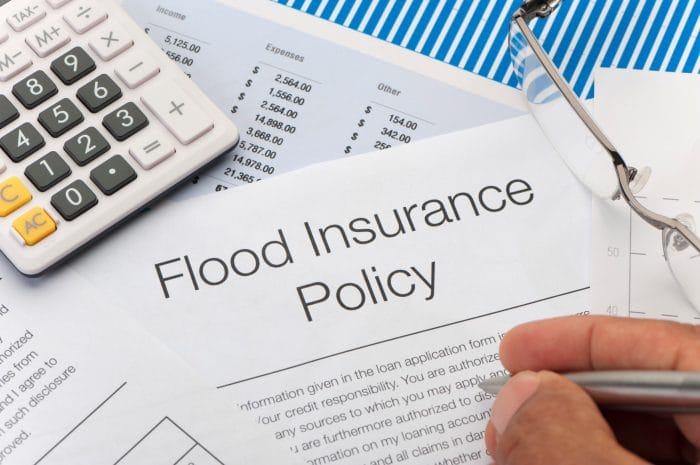
Dealing with a flood insurance claim can be a daunting task, but understanding the process and following the right steps can make it smoother. The claim filing process typically involves contacting your insurance company, gathering necessary documentation, and submitting the claim form.
Contacting Your Insurance Company
As soon as you experience a flood, contact your insurance company immediately. They will provide you with instructions on how to proceed with the claim filing process. You can usually contact your insurance company by phone, email, or through their online portal.
Gathering Necessary Documentation
To support your claim, you will need to gather various documents and information. This may include:
- A copy of your flood insurance policy
- Proof of ownership or occupancy of the damaged property
- A list of damaged items and their estimated value
- Photographs of the damage
- Receipts for any expenses related to the flood, such as cleanup or repairs
Submitting the Claim Form
Once you have gathered all the necessary documentation, you can submit your claim form to your insurance company. The claim form typically asks for information about the flood, the damage, and the coverage you are seeking. Be sure to fill out the form accurately and completely.
Documentation and Evidence
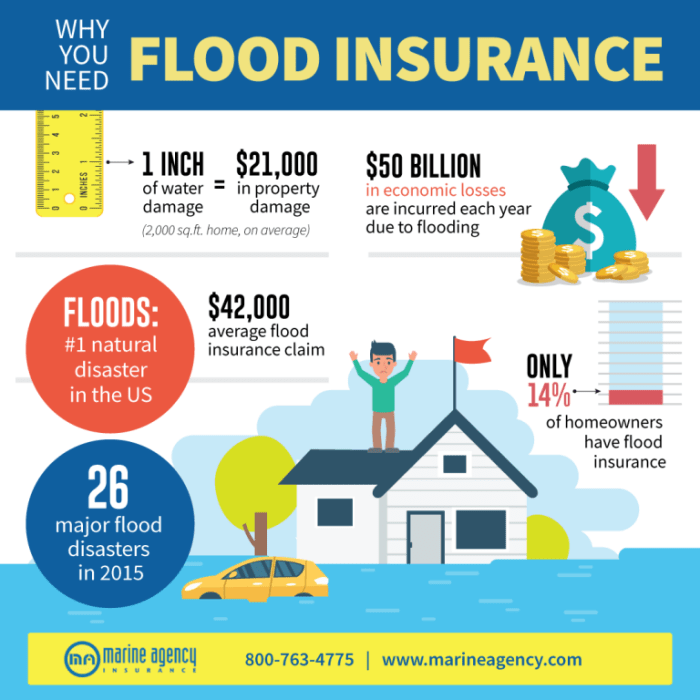
To ensure a smooth and successful flood insurance claim process, it is crucial to provide comprehensive documentation and evidence that accurately reflects the extent of the damages caused by the flood. This documentation serves as a solid foundation for the insurance company to assess the claim and determine the appropriate compensation.
Essential Documents and Evidence
The following is a list of essential documents and evidence that should be submitted along with the flood insurance claim:
- Photographs: High-quality photographs that clearly depict the flood damage to the insured property, both interior and exterior. These photos should be taken from various angles and distances to provide a comprehensive view of the damages.
- Receipts and Invoices: Original receipts and invoices for any expenses incurred as a result of the flood, such as repairs, cleanup, and temporary living arrangements. These documents serve as proof of actual expenses and are essential for reimbursement.
- Repair Estimates: Detailed estimates from qualified contractors or repair professionals that Artikel the necessary repairs and the associated costs. These estimates should be specific and itemized, providing a clear breakdown of the labor and materials required.
- Proof of Ownership: Documents that establish ownership of the insured property, such as a deed, title, or mortgage statement. This documentation verifies the claimant’s insurable interest in the property.
- Insurance Policy: A copy of the flood insurance policy, including any riders or endorsements, that Artikels the coverage terms, limits, and deductibles.
In addition to the above, it is also advisable to provide any additional documentation or evidence that may support the claim, such as:
- Flood Damage Report: A report from a qualified inspector or engineer that assesses the extent of the flood damage and provides recommendations for repairs.
- Building Permits: Copies of any permits or approvals obtained for repairs or renovations made to the property.
- Correspondence with Insurance Company: Any correspondence or communication with the insurance company regarding the flood claim, including claim forms, claim numbers, and adjuster contact information.
By providing comprehensive documentation and evidence, the claimant can strengthen their case and expedite the claims process, ensuring a fair and timely resolution.
Policy and Exclusions
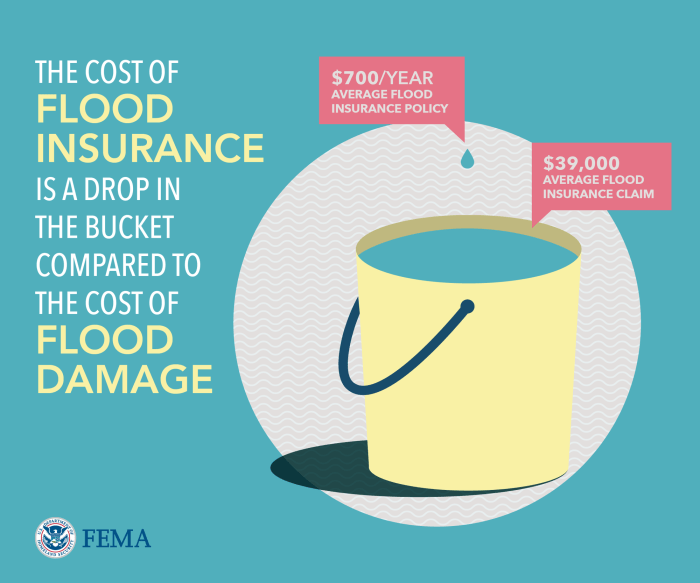
When it comes to flood insurance, it’s crucial to understand the different types of coverage and exclusions included in your policy. Knowing what your policy covers and what it doesn’t can help you make informed decisions and avoid surprises during a claim.
Types of Flood Insurance Coverage
Flood insurance policies generally offer three main types of coverage:
- Building Coverage: This covers the physical structure of your home or building, including the foundation, walls, roof, and attached structures like a garage or deck.
- Contents Coverage: This covers personal property inside your home, like furniture, appliances, electronics, and clothing.
- Additional Living Expenses Coverage: This covers the costs of living away from your home if it’s uninhabitable due to a covered flood event.
Common Exclusions in Flood Insurance Policies
It’s important to note that flood insurance policies typically have some common exclusions. These exclusions can vary depending on the policy and the company, but some of the most common ones include:
- Damage Caused by Earthquakes: Flood insurance policies generally don’t cover damage caused by earthquakes or tsunamis.
- Backups: Damage caused by sewer or drain back ups is usually not covered by flood insurance.
- Government Actions: Flood insurance policies don’t cover losses resulting from government actions, such as the failure of a levee or flood control structure.
Understanding the types of coverage and exclusions in your flood insurance policy is essential. It helps you make informed decisions, avoid surprises during a claim, and ensure you have the right coverage for your needs.
Claim Assessment and Inspection
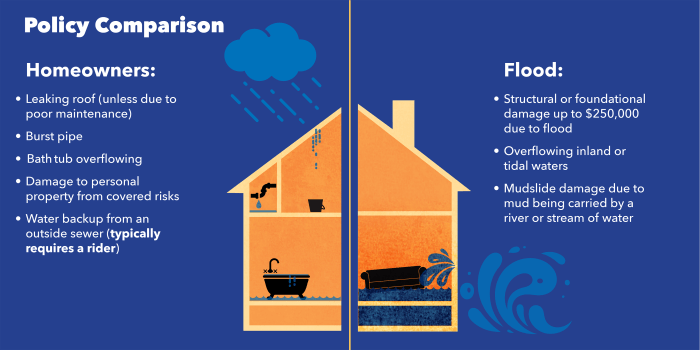
After receiving your claim, the insurance company will initiate the claim assessment and inspection process to determine the extent of the damage and the amount of coverage you are entitled to. This process typically involves an adjuster visiting the property to assess the damage and gather relevant information.
The Role of the Adjuster
The adjuster plays a crucial role in the claim assessment process. They are responsible for:
- Inspecting the damaged property and assessing the extent of the damage.
- Gathering information about the cause of the damage and the date it occurred.
- Documenting the damage with photographs, videos, and detailed notes.
- Estimating the cost of repairs or replacements.
- Negotiating a settlement with the policyholder.
Tips for Effective Communication
To ensure a fair assessment of the damage and a smooth claim settlement process, it is essential to communicate effectively with the insurance adjuster. Here are some tips:
- Be honest and transparent about the damage and the cause of the damage.
- Provide the adjuster with all the necessary documentation and evidence to support your claim.
- Be clear and concise when explaining the damage and your expectations.
- Be patient and understanding during the assessment process.
- If you have any questions or concerns, don’t hesitate to ask the adjuster for clarification.
Mitigation Measures
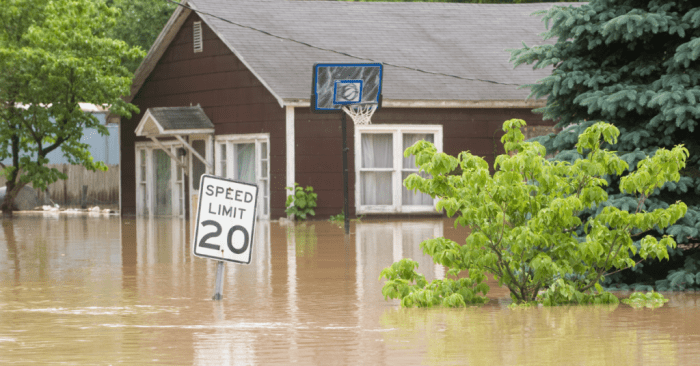
Swift and proactive action to mitigate further damage to your property after a flood can minimize losses and expedite the insurance claim process. These steps can help protect your property, reduce repair costs, and ensure a smoother claim experience.
Securing the Premises
After a flood, securing your property is crucial to prevent further damage and unauthorized access. Measures to consider include:
- Board Up Windows and Doors: If windows or doors are damaged or broken, cover them with plywood or other sturdy material to prevent water intrusion, vandalism, and theft.
- Reinforce Structural Elements: If the foundation or walls are compromised, seek professional help to reinforce them to prevent collapse.
- Install Temporary Roof Cover: If the roof is damaged, install a temporary cover to protect the interior from further water damage.
Preventing Mold Growth
Mold can quickly proliferate in damp environments, leading to health hazards and further damage to your property. To prevent mold growth:
- Dehumidify and Ventilate: Use dehumidifiers and fans to remove excess moisture from the air and promote airflow.
- Clean and Disinfect: Thoroughly clean and disinfect affected surfaces using appropriate cleaning solutions to remove mold spores.
- Remove Wet Materials: Remove and discard any water-soaked materials, such as carpets, drywall, and furniture, to prevent mold growth.
Performing Temporary Repairs
Temporary repairs can help stabilize the property and prevent further damage until permanent repairs can be made. Some measures include:
- Patching Leaks: If there are leaks in pipes or fixtures, use temporary sealant or clamps to stop the flow of water.
- Securing Electrical Systems: If electrical systems are damaged, disconnect the power supply and hire a qualified electrician to make temporary repairs.
- Clearing Debris: Remove debris from the property, including fallen trees, branches, and other materials, to prevent further damage.
Documenting Mitigation Efforts and Expenses
Keep detailed records of all mitigation efforts and expenses incurred. This documentation is essential for reimbursement purposes and demonstrating your proactive approach to minimizing damages. Consider the following:
- Maintain a Log: Keep a log of all mitigation activities, including dates, times, and actions taken.
- Take Photographs: Take comprehensive photographs of the damage and mitigation efforts. These visual records can serve as evidence of the extent of the damage and the steps taken to mitigate it.
- Save Receipts: Keep all receipts for materials, supplies, and services related to mitigation efforts. These receipts can be used to support your claim for reimbursement.
Negotiation and Settlement

Negotiating with the insurance company for a fair settlement amount is crucial to maximizing the claim payout. Effective negotiation involves understanding the policy coverage, preparing necessary documentation, and presenting a compelling case for the claim.
Effective Negotiation Strategies
- Research and Knowledge: Thoroughly review the insurance policy, including coverage limits, exclusions, and applicable clauses, to understand your rights and entitlements.
- Organize Documentation: Keep all relevant documentation, such as repair estimates, receipts, and photos, organized and easily accessible to support your claim.
- Open Communication: Maintain open communication with the insurance company throughout the negotiation process, responding promptly to requests for information or documentation.
- Professional and Polite: Approach the negotiation with professionalism and politeness. Avoid confrontational or aggressive behavior, as it may hinder the process.
- Consider Mediation: If negotiations reach an impasse, consider involving a mediator to facilitate a resolution that is fair to both parties.
Maximizing the Claim Payout
- Negotiate the Claim Amount: Review the initial claim offer from the insurance company and negotiate for a higher settlement amount if you believe it is inadequate.
- Document Additional Expenses: Keep track of additional expenses incurred due to the flood damage, such as temporary housing or repairs, and include them in the negotiation.
- Consider Legal Advice: If the negotiation process becomes complex or if you feel the insurance company is acting unfairly, consider seeking legal advice from an attorney experienced in insurance claims.
Claim Disputes and Appeals
Filing a flood insurance claim can be a complex and challenging process. If your claim is denied or the settlement offer is unsatisfactory, you have the right to dispute the decision and pursue an appeal. Here’s an overview of the steps involved in disputing a flood insurance claim:
Filing an Appeal with the Insurance Company
If you disagree with the insurance company’s decision, the first step is to file an appeal. This can typically be done by submitting a written letter or form to the insurance company. The appeal should include a detailed explanation of why you believe the claim should be approved or the settlement offer should be increased.
You may also want to include any additional documentation or evidence that supports your claim.
Documenting the Damage
It is important to thoroughly document the damage caused by the flood. This includes taking photographs and videos of the damage, as well as obtaining estimates from contractors for repairs. You should also keep receipts for any expenses incurred as a result of the flood, such as hotel stays or temporary housing.
Negotiating a Settlement
If the insurance company denies your appeal, you may be able to negotiate a settlement. This involves working with the insurance company to reach an agreement on a fair settlement amount. It is important to be prepared to provide documentation and evidence to support your claim during negotiations.
Pursuing Legal Action
If you are unable to reach a settlement with the insurance company, you may need to pursue legal action. This involves filing a lawsuit against the insurance company in court. It is important to consult with an attorney if you are considering pursuing legal action.
Preventing Future Flood Damage
Floods can cause devastating damage to your property, but there are steps you can take to prevent future flood damage and protect your investment.
Flood-Resistant Construction Materials and Techniques
Using flood-resistant construction materials and techniques can help to minimize the risk of flood damage to your property. These materials and techniques can include:
- Elevated Appliances: Raising appliances above the potential flood level can help to prevent damage.
- Sump Pumps: Installing a sump pump can help to remove water from your basement or crawlspace in the event of a flood.
- Flood Vents: Flood vents allow water to enter a structure, equalizing pressure and reducing the risk of structural damage.
- Flood-Resistant Materials: Using flood-resistant materials, such as concrete, steel, and fiberglass, can help to protect your property from flood damage.
- Floodproofing Techniques: Floodproofing techniques, such as sealing openings and installing backflow preventers, can help to keep floodwaters out of your property.
Flood Insurance Policy Maintenance

Sustaining a comprehensive flood insurance policy is essential for safeguarding against financial losses caused by floods. This section emphasizes the importance of policy upkeep, including periodic reviews, coverage adjustments, premium management, and continuous coverage.
Maintaining an up-to-date flood insurance policy is crucial for several reasons. Firstly, it ensures that your coverage limits align with the evolving value of your property and belongings. Secondly, regular policy reviews allow you to stay informed about any changes in policy terms, conditions, and available discounts.
Thirdly, proactive adjustments to coverage limits prevent potential underinsurance, which could leave you financially vulnerable in the event of a flood.
Managing Flood Insurance Premiums
Managing flood insurance premiums responsibly is vital for maintaining continuous coverage. Here are some tips to help you manage your premiums effectively:
- Shop around for quotes: Obtain quotes from multiple insurance providers to compare rates and coverage options. This can help you find the most competitive premium for your needs.
- Consider a higher deductible: Opting for a higher deductible can lower your premium. However, ensure you select a deductible that you can comfortably afford to pay in the event of a claim.
- Explore discounts: Many insurance companies offer discounts for various factors, such as installing flood mitigation measures, maintaining a claims-free history, and bundling your flood insurance with other policies. Inquire about available discounts to potentially reduce your premium.
- Review your policy regularly: Regularly reviewing your policy ensures that you are aware of any changes in coverage or premium rates. It also allows you to make adjustments as needed to maintain adequate protection.
Ensuring Continuous Coverage
To ensure continuous coverage, it is essential to pay your premiums on time and in full. Late or missed payments can result in policy cancellation, leaving you vulnerable to financial losses in the event of a flood. Additionally, consider setting up automatic payments to avoid the risk of忘記繳費 and potential coverage lapses.
Resources and Support
Navigating the complexities of flood insurance claims and recovering from flood damage can be daunting. Fortunately, there are numerous government agencies, non-profit organizations, and resources available to assist homeowners in these challenging situations.
Government agencies such as the Federal Emergency Management Agency (FEMA) and the National Flood Insurance Program (NFIP) provide a wealth of information, guidance, and financial assistance to flood victims. These agencies offer programs that can help homeowners rebuild their homes, repair damaged property, and obtain financial assistance to cover losses not covered by insurance.
Community Support
Community support plays a vital role in the recovery process after a flood. Neighbors, friends, and local organizations often come together to provide assistance to those affected by the disaster. This support can range from providing temporary housing and food to helping with cleanup and rebuilding efforts.
Seeking assistance from community support networks is crucial for flood victims. It not only helps them cope with the emotional and financial toll of the disaster but also accelerates the recovery process and restores a sense of normalcy to their lives.
Final Conclusion
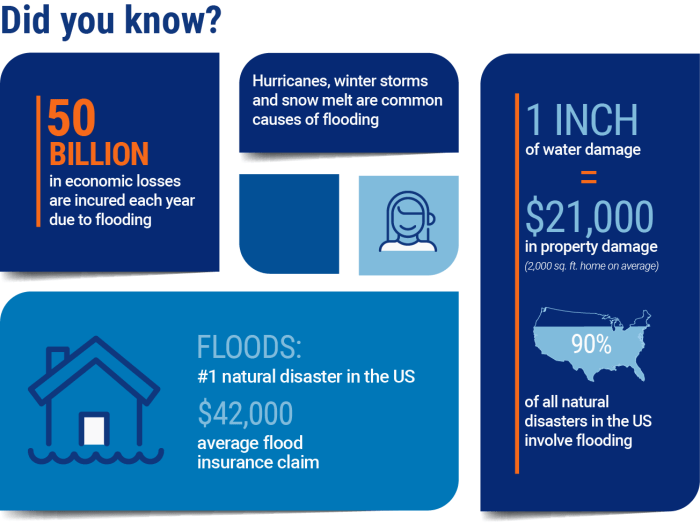
Remember, dealing with flood insurance claims can be challenging, but with careful preparation, effective communication, and a proactive approach, you can ensure a favorable outcome. Stay informed, document meticulously, and don’t hesitate to seek assistance from experts or legal counsel if necessary.
By following the tips Artikeld in this guide, you can navigate the claims process with confidence, ensuring a swift and satisfactory resolution.
FAQ Summary
Q: What are some common exclusions in flood insurance policies?
A: Common exclusions include damage caused by earthquakes, sewer backups, and damage to personal belongings unless specifically covered by the policy.
Q: How can I prevent future flood damage to my property?
A: Consider elevating appliances, installing sump pumps, and creating a flood preparedness plan. Additionally, flood-resistant construction materials and techniques can help minimize damage.
Q: How can I manage flood insurance premiums and ensure continuous coverage?
A: Regularly review your policy and adjust coverage limits as needed. Consider discounts and explore options for reducing premiums, such as elevating your property or installing flood mitigation measures.



